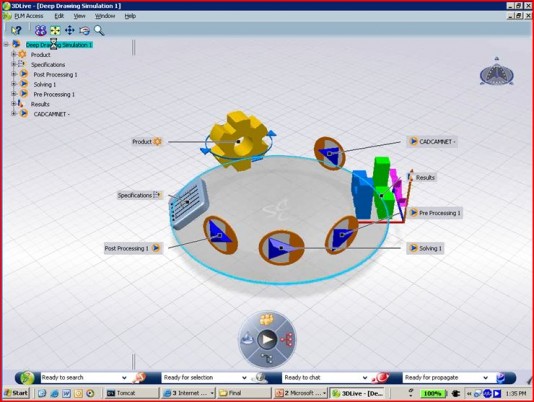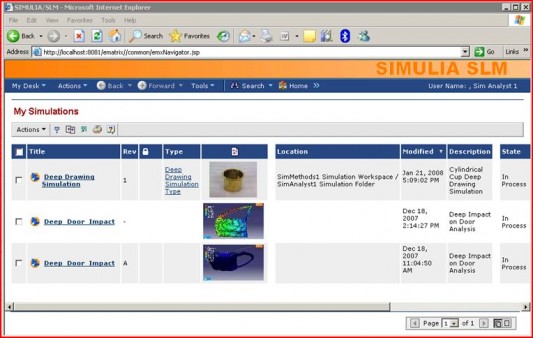In 2008 Dassault Systèmes announced plans for Simulia SLM, a new product suite for performing and managing simulation processes; SLM = Simulation Lifecycle Management. It was to be an expansion of the former Abaqus product line leveraging Dassault’s V6 PLM technology. From the archives of CADCAMNET, acquired in 2010 by Jon Peddie research.
By Randall S. Newton
CADCAMNET, April 17, 2008—When Dassault Systèmes (DS) recently announced Simulia SLM, a new product suite, I immediately groaned. That’s just what the engineering world needs, I thought sarcastically, another TLA (three-letter acronym). Simulation Lifecycle Management; what will Dassault think of next? But it wasn’t two minutes into an interview with Dassault’s Paul Lalor when I realized that the ideas behind SLM make it the best TLA to come down the pike in quite a while. As envisioned by Dassault, it is a technology that will have a positive impact on the way organizations perform and manage their simulation processes.

The use of simulation has become vital to product development and innovation. Simulia SLM offers new abilities to accelerate product development by organizing the mass of simulation data now spread across departments. Dassault says Simulia SLM will be a repository for simulation data that allows a company to capture, re-use, and re-deploy simulation, to create best practices surrounding simulation, and to foster innovation through cross-functional engineering.
The goal is to create a single collaboration environment for all simulation domains. Today, simulations are often performed by experts in the back room. “The number of them is too few and their contributions are often too little,” notes Lalor.
Simulia SLM is the first significant expansion of the Dassault simulation product portfolio since the Abaqus acquisition. It leverages simulation by borrowing from Enovia PLM technology created for Dassault’s V6 technology generation. Lalor says for Dassault, creating the first version of SLM was a rapid development cycle, once the pieces were in place.
Dassault says Simulia SLM will deliver the ability to manage all data associated with simulations, integrate and control the execution of simulation applications, carry out operations such as query and version control, administer access privileges, and perform and review simulations in a distributed, collaborative environment. In other words, SLM will do for simulation what PLM does for product definition.
Dassault says SLM will be compatible with simulation authoring applications developed by Simulia, Dassault Systèmes, third parties, and customers via a Connectors Framework. Connectors will ship initially for Abaqus Unified FEA, Catia, and a variety of third-party applications such as Nastran, HyperMesh, AcuSolve, and STAR-CD. Dassault says customers will be able to easily configure Connectors to their specific applications.
Right now Simulia SLM is available to a few selected partner/customers who are helping Dassault work the kinks out of the product. The general release is planned for mid-year.
Why SLM?
Dassault’s Lalor, part of the Simulia product management team, says simulation could be part of PLM, but that the specifics of simulation make doing so tough. He likes to explain why there is a need for a separate way to manage simulations by talking through what it takes to make a bottle of shampoo. To the average consumer shampoo looks like a rather simple product. But before the bottle is filled and sent to the store, someone has to:
- Analyze the physics and structural mechanics of the bottle;
- Perform computational chemistry simulations on the plastic;
- Study the impact of the fluid mix on fabrics, hair, and the environment;
- Use computational fluid dynamics to study mixing simulations;
- Plan for use of existing company assets, mixing tanks and paddles;
- Do manufacturing simulations on the packaging;
- Study product and bottle stability issues.
You can’t manage all this in PLM, Lalor says, because the data and the processes and the tools are just too diverse. “Our customers want a product that manages this whole suite of simulations.” Lalor says. SLM thus becomes a necessary software foundation for fostering collaboration, helping experts from several domains to work together on a single product design. “Bringing these domains together rapidly requires special treatment, to manage the drivers of innovation and get to market before competitors.”
It would be tough for an existing PLM product to both manage the simulations and also associate them to the products being simulated; tough, but not impossible. Dassault decided to wait until the launch of its V6 technology platform to create SLM as a separate offering, so they could take advantage of its more visual nature and the new MatrixOne-based platform.
Engineering targets
Engineers are often presented with marketing requirements for a new product. In SLM, Dassault refers to these as “engineering targets.” If a new automobile needs to go to market with a five-star crash rating, that’s a marketing requirement. Engineers must translate the marketing goal into a set of engineering requirements. Lalor says SLM can be the single source of information for all the various tasks associated with getting to the five-star rating. Various engineering groups can see how others are progressing in an environment that encourages cross-discipline efforts.
Before it was acquired by Dassault, Abaqus already had a solid footprint in tire manufacturing. It had tools for studying the 2D cross section mesh of a tire, simulating the mounting on rims, testing inflation pressures and the effects of vehicle weight. All those processes can be automated in SLM Version 1. The next release will add optimization routines for vertical and lateral stiffness and to optimize the structural definition for resistance to wear. “This is something that can definitely be put on the desk of design engineers who can then arrive at the optimal design according to their requirements,” Lalor says.
Most of the assets in the Simulia product line were acquired from Abaqus. The SLM product inherits this, Lalor says, plus the Catia simulation applications. “We have taken Simulia expertise in simulation data and processes and married it up with Enovia technology in data management to form this cross-brand, cross-functional team, to bring simulation data processes and tools into the overall product development process.”

Decision support yet to come
Coming in the future will be decision support; the plan is to expose simulation results in a dashboard that shows both the progress of functional requirements and the specifics of various ongoing simulations. “The goal is to do more simulations and to do them faster,” says Lalor. “More simulations and less physical testing equal more insight before we build and break. We can’t completely eliminate physical testing, but we can delay and minimize.”
Lalor says there will be three ways to deploy SLM. First, some will use it as stand-alone environment, not hooking it up to a PLM system. Lalor says doing this won’t bring all the benefits possible, but it would make sense as a starting place for companies buried in simulation data coming from a variety of products. Some customers may choose Dassault’s SLM as an upgrade to their existing non-Dassault PDM. “We have robust hooks into other PDM systems,” says Lalor. The third way to deploy would be to as part of an integral Dassault-based PLM V6 environment.
Lalor says SLM will be highly configurable but still useful right out of the box. “This can’t be a customization sale; SLM has to be functional right away or it won’t sell well.” Compared to design and manufacturing, simulation is a much smaller market. “The community has to manage it, this is a key requirement,” says Lalor. “Offering them a highly flexible modeling environment is crucial to our success.” Version 1 will connect to a variety of solvers.
The competition
Lalor says Dassault likes the SLM competitive landscape. He says Dassault has caught up to MSC.Software in simulation technology, and that Dassault has a considerable lead in data management. Siemens PLM has the data management side but “not the simulation expertise or client portfolio that we do. We feel we are in a pretty good position to enter this market. We entered the market late but we are catching up fast. We have pretty big plans for expanding on this whole SLM product space.”
Lalor says the idea for SLM came from Dassault customers. “When we were just Abaqus we had no interest in entering into this. There was definitely more and more pull from customers to help them manage simulation data.” They told first Abaqus, then Dassault, that simulation data was often too little too late, and that collecting simulation data was time consuming and complicated.
CADCAMNET comments
Simulation generates a ton of data, and more of the work is being done in high performance computing (HPC) environments. “The sheer volume of data is daunting,” notes Lalor. Having a separate PLM-like environment for simulation data will help engineers manage the metadata and content better, no matter where the data was created.
The goal for Dassault with Simulation Lifecycle Management is to bring the world of simulation to the desktop and to make simulation a collaborative process. As Dassault’s Version 6 technology matures, the product will become a visual dashboard with links to products, specifications, and results.
The first markets for SLM will likely be automotive and aeronautics, for the obvious reasons of product complexity and the massive amount of simulation required. But the consumer packaged goods industry may well buy into SLM as fast as transportation, as a way to cope with ever-decreasing design cycles.
They certainly won’t solve it all in the first release, but Dassault recognizes that creating an SLM environment will be a process. Given the slow progress MSC.Software is showing with its switch to enterprise simulation, there is no reason to think Dassault is late to the game. Indeed, given their built-in advantages as a CAD/PLM vendor, many existing Dassault customers will be waiting to give them the first chance to prove the validity of SLM before looking elsewhere.





